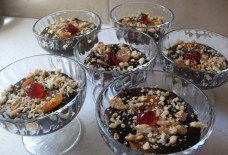Exploring the Imperial Cites of Morocco (Part 1)
By: Habeeb Salloum/Arab America Contributing Writer
Taking a ferry from Algeciras to Tangiers, unexperienced travellers might think they are leaving one world and entering another. Landing on North African soil, it will appear to many that the modern West has been transformed into the mysterious East. Yet is it so? For hundreds of years the history of the Iberian Peninsula and North Africa were one. When the Moors in Spain were the pathfinders of the world, Morocco was under their sway. Later, when the tide turned, armies from the Sahara preserved, for a few centuries, parts of the Iberian Peninsula for Islam.
Mighty dynasties arose from the southern Atlas Mountains and halted the European Christian onslaught. Each dynasty built its own Imperial Capital, flourished for a period, then was overwhelmed by others. The Almoravides, Almohades, Merinides, Saadians and Alaouites (the dynasty which rules Morocco today) all had a hand in the construction of these Imperial Cities.
Rabat, Meknes, Fez and Marrakesh, what memories of Moorish grandeur they engender! For years I had read and was intrigued by their history. Many times, in my fantasies, I had planned to visit these historic cities. Unnumbered were my visions of the glorious sultans, from the Moorish past, riding from these cities on prancing steeds to stop the crushing advance of Christendom.
Now, as our bus left Tangiers for Rabat, my heart beat faster. I, with my family, were beginning an historic journey of fulfillment – a modern ramble through a romantic past. Indeed, it appeared that many of our fellow travellers had come alive from that Moorish medieval world. Although a number were dressed in western garments, others were wrapped in flowing robes – once the attire of Arab Spain. A mixture of the exotic past and today’s world. Surveying the as our bus travelled southward was like seeing history alive.
Rabat
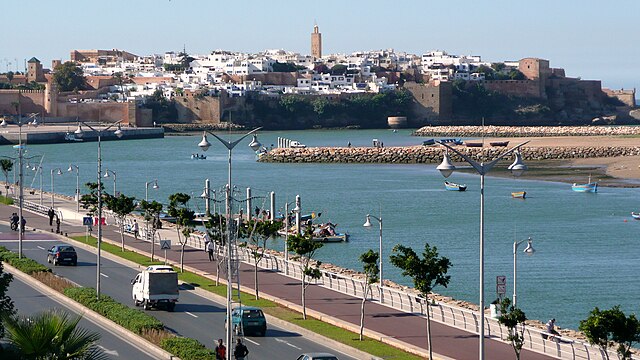
When our eyes beheld its modern streets, Rabat appeared like a reincarnated work of art from the past. The most recent of the Imperial Cities, it seemed to say, “I am a city of bygone ages and present grandeur. I have kept my traditional past enshrined in a modern setting”.
Soon we were inside its ancient walls which had protected the city before it was occupied by the armies of France – now long gone. I could hardly wait to walk its tree-lined streets. The feeling of elation and anticipation to explore this Imperial City, filled my soul.
Our first venture was to visit Hassan’s Tower around which stands the ruins of a partly built massive mosque. It was erected by the Almohade Sultan Yaqub al-Mansur to hold his army of 100,000 men, but it was never finished. Today, in a miniscule portion of its huge area is a small mosque and the mausoleum of Muhammad V (father of the present king) – a tomb which is the epitome of traditional Moroccan artistic splendour. Al-Mansur also built the Great Mosque of Seville which was converted into a cathedral after the Spanish Reconquista. Only the minaret, now called La Giralda, and part of the mosque’s walls remain. Nevertheless, the religious structures constructed during the reign of this famous sultan were not all left unfinished or lost forever to later conquerors. The Great Mosque of Marrakesh, al-Koutoubia, stands in our times as a monument to the grandeur of his empire.
Attached to the new city, yet, medieval in its construction and atmosphere is the Medina – the old town. This original Rabat, founded in the 12th century, is the interesting part of the city. In its quarters and environs are number of relics from the past. Perhaps, the most enjoyable are the delightful Andalusian Gardens, built in the same fashion as the gardens which were built in Moorish Spain. They are a living reminder that once Morocco and the Iberian Peninsula were one. Replicas of these Moorish paradise-like enclosures were later to spread to the far corners of Europe and the Americas.
Near the old city walls are the ruins of Chella – once the Roman city of Sala. Within the partly standing walls are gardens, tombs of saints and Roman and Islamic ruins. A visitor needs only a few hours in this ruined city to relish the splendour which once was.
Before departing from Rabat, we, like most tourists, did not want to miss the royal prayer ritual. On Friday morning we stood with thousands of others near Dar al-Makhzen – the Royal Palace – waiting to view the traditional ceremony. From his palace the king came across the square in a royal carriage surrounded by colourfully dressed guards. We were still waiting when he returned from the mosque, after prayers, enrobed as an imam and riding a white horse followed by his richly attired guards. Truly, it was a breathtaking scene from the Arabian Nights.
On the Road to Meknes and Fez
We left the capital of 20th century Morocco with its imperial remains and modern type Moorish edifices in a crowded CTM bus. Every seat appeared to be taken, but we were crowded in. Unlike in the West where people are annoyed with crowds, here everyone seemed to be in a pleasant mood. Rousing Arabic music came from the driver’s stereo while lively conversation went on all around us. It was evident that even in travelling, the Arabs continue with their social life.
We passed through cork and eucalyptus forests before stopping for roadside refreshments. The smell of qadhban (barbecued meat) filled the air. Like our Moroccan fellow passengers, we soon were consuming these spicy delicious tidbits of the wayside. When it came time to leave our hunger had been satisfied, but the aroma of qadhban still was as enticing as ever.
Before we continued our journey, the driver allowed a beggar, unshaven and in tattered clothes, on the bus. Most of the passengers, beginning with the driver himself, gave him a few francs as he passed. No one was upset. In the codes of Islam, giving to a beggar is favoured by God.
Meknes

The rich lush farmlands and endless vineyards continued until we reached the outskirts of Meknes – our second Imperial City built by a mighty sultan. When he inherited his kingdom in the 17th century, Moulay Ismail was bequeathed a country full of civil strife. The coastline was occupied by Europeans and the land of illustrious dynasties had become a nation of warring tribes. In the 55 years of his rule, he unified the country, drove the Europeans out from most of his domains and made Morocco one of the first ranking powers of his era. To the Europeans he became known as the cruel Sultan. However, to the Moroccans he was a pre-eminent ruler who unified the country and drove out the foreigners.
For his revived nation, he built a new Imperial Capital. With determination, often working with his own hands, he constructed Meknes as his impregnable fortress city. This semi-forgotten town, founded in the 10th century, was soon to match the capitals of Europe. He transformed an insignificant town into a splendid metropolis which rivalled Paris – the most important world capital in that epoch. Not to be outdone by his contemporary Louis XIV, he built a complex of palaces to compete with Versailles in its age of glory.
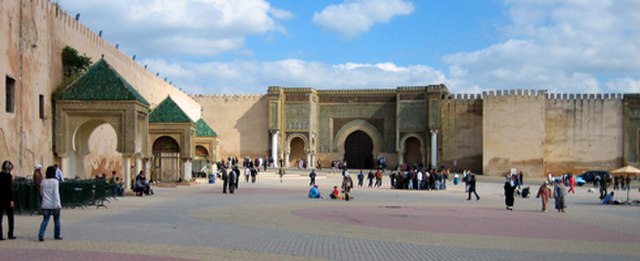
Today, most of this city is in ruins. A mausoleum to Moulay Ismail, the ruins of his stables which once held 12,000 steeds, a renovated palace and 25 kilometres of massive walls are the most notable remains. The gates still existing in these walls are impressive examples of Moorish architecture. The most imposing is Bab Mansur, an ornamented monumental gateway decorated with green and white ceramics.
We entered Moulay Ismail’s Imperial City through this gate. Once this opening was the main entrance to the largest palace-complex in the world. In its days of glory this Royal City was filled with palaces, gardens, mosques, stables and mausoleums. Although now a faint shadow of its former self, it still shows traces of its once, overwhelming splendour. Even after centuries, the echoes of its fabled wealth and grandeur still can be felt. The ruins are so extensive that we hired a taxi and guide to explore the still standing remains.
Fez
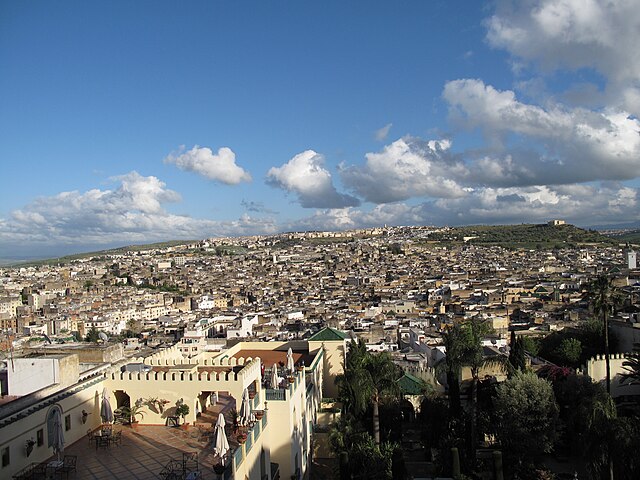
Fez, a bare 50 kilometres from Meknes, is a city from the Middle Ages. Unlike any other town in the world today, it has preserved its medieval character almost intact. No automobile is allowed within its walls to destroy the ancient atmosphere of its glorious age. However, when our bus deposited us in the CTM station, located in the modern part of the city, there was no indication of historic Fez.
This most Arab city in North Africa was the initial capital of Arab-Islamic Morocco and the first of the Imperial Cities. With its establishment in 808 A.D. by Idriss II, the history of Arab Morocco began. Other cities in later centuries became capitals, but Fez has always been the heart and brain of the country. It has remained until our times as the intellectual and spiritual capital of Morocco and the surrounding lands.
Within the old city walls are innumerable relics from the town’s fabulous past. It would take a book to enumerate and classify their attributes. The historic Arab schools, mosques, public buildings and homes of the wealthy are countless. To walk through the old city exploring these structures is an adventure into Moroccan history. Most of these stately edifices were built or renovated during the Merinide era – the golden age of fez. They are marvellous examples of Moorish architecture and reflect the city’s brilliant lofty epoch.
The most majestic of these structures is, without doubt, the Qarawiyin, Morocco’s holiest mosque and the home of the world’s first university. It is the most imposing building in Fez and one of the grandest mosques in the globe. Although no non-Muslim can walk within its walls, a traveller may view its magnificence from one of its 14 doorways.
The banning of non-Muslims inside the mosques of North Africa is not as strange as it may seem. In the period prior to the defeat of the Moors in the Iberian Peninsula, Christian scholars from all over Europe would journey to Arab Spain and North Africa to study in the mosque-schools of these lands. One of the popes, Sylvester II, who is credited with a leading role in introducing mathematics into Europe, is said to have studied at the Qarawiyin. Thus, this mosque-university had a hand in transmitting the Arab numerals with the zero to the West. However, after the persecutions and mass deportations of the Moors from Spain, Islam in North Africa reacted. Christians were banned from entering the mosques in these lands. Thus, as the Muslims were being eliminated in the Iberian Peninsula, fanaticism grew in North Africa. Such is the history of warring nations.
Besides the Qarawiyin Mosque, there are many other important monuments in the old city of Fez. Bab Bou Jeloud, the gate by which we entered Morocco’s museum city, is a photographer’s delight. Its blue and green tiles and the ancient buildings seen through its opening gives it a picturesque aura. The numerous madrasas (schools) are all worth a visit. On the other hand, a stop at the madrasas of Bou Inania and El-Attarine, both wonderful masterpieces of Moorish architecture, will suffice a hurried traveller. Also, a passing view of the tomb of Idriss II and al-Andalus Mosque are unforgettable sights for any visitor.
Fez’s Arab-Islamic past is reflected not only in its ancient monuments, but also in its colourful streets and people. Into these avenues, never touched by the wheels of an automobile, the city invites the adventurous traveller.
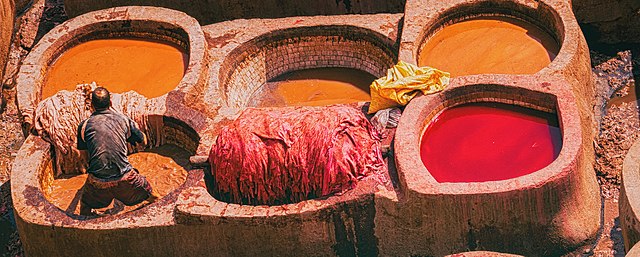
We plunged into the noise, excitement, colour and charm of the medina – the heart of town, unparalleled by any other city on earth. We were fascinated with the street life. Artisans in their tiny shops, merchants calling customers from their doorways, donkeys transporting goods as their drivers shouted bālak (make way), and food stalls from which arose the aroma of barbecued meat, had us enthralled. Each street had its trade. The brass and copper, gold and silver, fabric, leather, perfume and spice streets were all a true reflection of the world in the Middle Ages.
We moved deeper into the city until the stench of leather-dyeing vats filled our nostrils. This medieval tanners’ quarter, where the wold famous Moroccan leather is made, was our last stop. Like other travellers who had walked the streets of the medina, we had walked through a part of world history. In our minds there was not doubt, Fez had to be the most overpowering of Morocco’s four Imperial Capitals. It was hard to tear ourselves away that evening from this bewitching city of nobility and learning.
The next day, before we ended our three-day visit, we took a taxi to the Hotel des Merinides, built amid the tombs of the Merinides sultans, overlooking the city. From this viewpoint, fez appeared like a fairy tale town built by men of magic. Turning away after this last glance, we bade farewell to Morocco’s most historic Imperial City.


